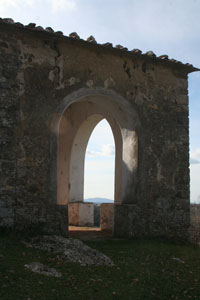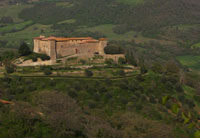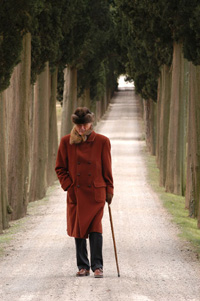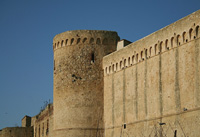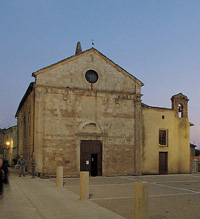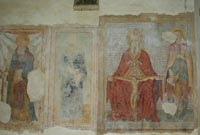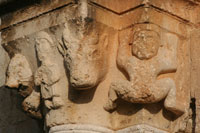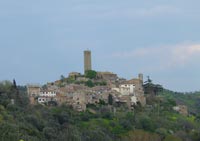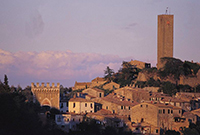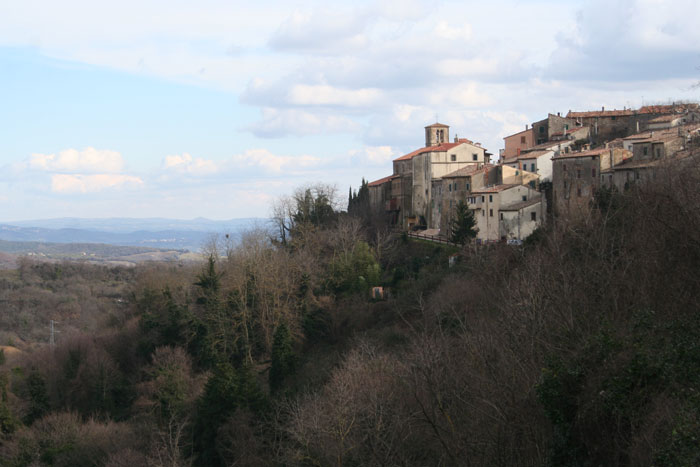 |
|
Scansano |
|
Scansano |
| Scansano is built in the hilly Maremma inland, along a strip of land between the coast and the slopes of Mount Amiata. Eevery summer, the city rediscovers the estatura: a practice in use since the Middle Ages according to which public offices of Grosseto, with all officials and their families, moved in the summer months, from the malarial plains to spend the summer vacation in the cool and salubrious hills of Scansano, harvesting. First settled by the Etruscans and the Romans, as demonstrated by the archaeological site of Ghiaccio Forte, it was ruled by the Aldobrandeschi family and then by the Santa Flora counts in the sixteenth century. After a period of socio-political stagnation under the Medici, the town showed demographic and urban growth under the Grand duke of Lorraine. The establishment of the so-called estatura or summer migration at the time of Peter Leopold I of Lorraine (circa 1737), to escape the malaria infestation present along the coastal areas due to their enlarged swampland, and the arrival in Scansano of several wealthy families, summoned by the Grand Duke to invest in and enhance the area, brought new possibilities for the development of the Maremma region and especially for Scansano. While large sections remain rugged and wild, as though man had not yet arrived, others immediately remind you of the centuries' old wine making tradition. A tradition that today produces one of the best known Italian DOC red wines in the world, the Morellino di Scansano. There are several buildings from the 15th and16th centuries along the main street: Palazzo Vaccarecci can be identified by the family coat of arms on the facade, the Romanesque church of San Giovanni Battista and the small square with the Pretorio that was the seat of Grosseto's civic offices during the "estatatura". The church of the Madonna delle Grazie, also known as the church of the barrel, is located outside the old centre and was very much reworked in 1862. Also outside the centre are the convent of the Patrero, originally the Aldobrandeschi Castle, and the Castle of Montepo, a massive and still intact fortress from the first half of the 16th century, circled by a high wall with four corner reinforcement embattled towers. The province of Grosseto is one of Tuscany's emerging wine regions with eight DOC designations, half of which were created in the late 1990s. Maremma is also home to Tuscany's newest DOCG, Morellino di Scansano, which makes a fragrant, dry Sangiovese based wine. |
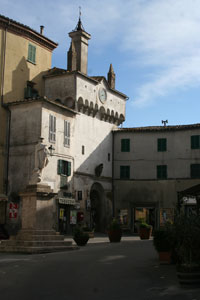 With the practice of summer migration, for six months of the year, from June to October, the government offices of the province of Grosseto moved to Scansano. |
|||
Morellino di Scansano DOCG is an Italian red wine made in the hilly environs of the village of Scansano. Morellino is the local name for the Sangiovese grape varietal. The wine, which was granted DOC status in 1978, and upgraded to DOCG status from the 2007 vintage, is made from at least 85% Sangiovese.
Morellino di Scansano wine cooperative |
||||
|
||||
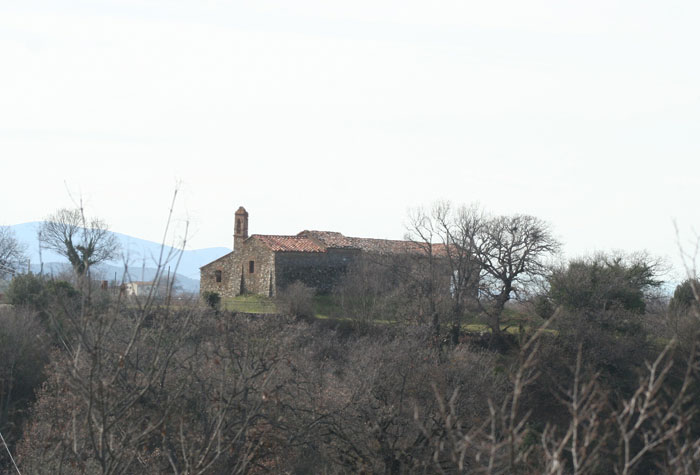 |
||||
Montorgiali, Santuario di San Giorgio |
||||
| The small castle of Montorgiali, documented since the 12th century, has preserved the ruins of the Keep, with wide round-arch windows, loopholes and the remains of the shelves of the machicolations. The Church of St. Blaise has a Romanesque structure, although it has been heavily restored, as the apse and the bell-tower bear witness. In April Montorgiali holds the festival in honour of St. George, linked with an interesting cycle of local legends. Part of the festival is the costume horse-ride to the church dedicated to the Saint, just outside the urban centre. Castello di Montorgiali, of mighty look because of its structure (facciavista) was built on the top of a knoll and has still today important arched windows and shelves of "piombatoi" which are now disappeared. The castle and the village suffered the ups and downs deriving from the hostilities between the Aldobrandeschi of the branch of St Fiora and the Republic of Siena. The counts of Montorgiali, who were at first vassals of the Aldobrandeschi, in 1224 sided with Siena and supported expensive wars that forced them, to face the expenses, to cede the rights of some properties among which Castiglioncello and its relative district. In 1378 Montorgiali was sold to the Republic of Siena. The Castle of Montorgiali is now a private property. Montorgiali is reached from the locality Bivio Montorgiali, on the S. S. 322 Grosseto-Manciano, app 19 km from Grosseto. Outside of the inhabited area of Montorgiali you find the Santuario di San Giorgio (the Sanctuary of St. Giorgio). A celebration in honour of St. Giorgio is scheduled annually for April 23. |
||||
| Castell di Montepò and Castello del Cotone |
||||
The Castello del Cotone (Castle of Montepo) which, dating back to the Middle Ages, was an important stronghold for the Cotone family, the powerful city of Siena, and of the Tolomei Counts.
|
||||
| The Convento del Petreto (Covent of Petreto) was created as a convent for the Franciscan order and amongst the famous religious figures who have stayed there, is St. Bernardino. In 1507 the count Guido Sforza opened the convent with its relative church dedicated to St. Pietro to the Petreto. The convent part is, at present, a private property whereas the church is part of Scansano’s parish property. |
||||
| To the west on the SS323, the walled city of Magliano in Toscana has a Sienese-style Palazzo dei Priori, and the church of San Giovanni Battista, with a Renaissance façade. The territory of Magliano in Toscana is characterized by numerous remains of Etruscan civilization. One interesting part is the old town surrounded by walls dating from the late Middle Ages and the Renaissance period. Passing the highway leading to St. Andrew we can find in the fascinating ruins of the monastery of San Bruzio. Monastero di San Bruzio, out of town and symbol of Migliano, is also wrapped in legend. Its picturesque ruins stand lonely among the olive trees. Pereta and Montiano are two remarkable places worth visiting for their panoramic positions, as well as for their historical memories. At about 11 km away from Magliano, you can find another village, Montiano, dated back to the Roman and Etruscan time. Montiano was built on the foundations of a castle built around the Mille Aldobrandeschi, although not too retains its origins. You can enjoy a wonderful view on Marenna from its little squares.The nearby hilly village Pereta, where Pia dei Tolomei is said to be imprisoned, is dominated by a big Tower (Torre dell'Orologio), which was part of the old fortress. There is the church Pieve di S. Maria of the 15th century, whose facade is decorated with a valuable rosette and a bell tower. |
||||
| Magliano in Toscana |
||||
| The territory of Magliano in Toscana is situated in the heart of Maremma, in a predominantly hilly landscape, dotted by olive trees, vineyards and old stony houses typical of classic Tuscany. There are also rough expanses of impenetrable bushes and fantastic marine corners. Magliano is a medieval village enclosed within powerful boundary walls accounting for three beautiful churches (San Martino, San Giovanni Battista and la Santissima Annunziata) included within the dwelling area. Another church, outside the town's walls, St. Bruzio, stands out in between a field of olive trees.
|
|
|||
| The town walls of Magliano represent one of the most interesting and complete Medieval defense systems of the entire Maremma region. The walls reveal two different types of military architecture: the more ancient side is Aldobrandesco on the south-eastern side, with square plan towers (its construction ended in 1323); the Sienese part, fifteenth century, on the western side, with six semicircular towers and bastions almost all with loopholes. Along the main street you will find Palazzo dei Priori (1425), while outside the town walls there's the Romanesque church of Annunziata, born as an oratory to honor the Madonna del Latte. Magliano has important middle age buildings, like palazzo Checco il Bello. The churches of S. Martino and S. Giovanni Battista host interesting frescoes by the school of Siena. The Chiesa dell'Annunziata, the SS Annunziata church, built over the ruins of a pagan temple, with bell-shaped facade in Romanesque style and beautiful portal surmounted by a travertine architrave. The church was widened during the XV century with the addition of an apse and a small sail-shaped bell tower. Inside it hosts The Madonna feeding the Child, one of the most beautiful works of art by Bartolomeo di Lando, known as Neroccio (1447/1500), at the high altar, and two paintings depicting the mystery of the Annunciation. The walls are decorated with frescoes from the Sienese school. Also interesting, the shrine with its hexagonal base in the shape of a classical small temple of the XVI century. The church of S Martino, in Romanesque shape, built starting in the year 1000. The facade has a portal whose jambs are decorated with two dragons, one rode by a human fi gure, and a double lancet window with a column without capital. The internal part is in the shape of a Latin cross and the walls have been decorated with many frescoes of the Sienese school (XV-XV century). On the right external side made with ashlar stone a portal with staircase opens up. It is composed by two superimposed arches. The remains of a fourteenth century frescoe depicting the Madonna with Child and Saints Peter and Paul are barely visible in the lunette. The Chiesa di San Giovanni Battista, he church of San Giovanni Battista, Romanesque with several Gothic features, has an elegant Renaissance facade. The inside, with its single nave, is characterized by four round arches with frescoes of the Sienese school depicting Saint Rocco, Saint Anthony and the Trinity, Saint Stephan, Saint Sebastian and Saint Francis receiving the stigmatas, XIV century. The baptismal font is interesting with its shaft decorated with classical motives. |
||||
| The origin of Magliano in Toscana are to research in a long way past, when the Etruscan coming from Marsiliana leaved the-territories in the valley of Albenga rive for move near of modern site, founding the city of Hea or Feba. Proof of this period are numerous tomb a camera, dating back to VII century. In the town surroundings there are besides many objects, the leaf called Piombo di Magliano, that is in the Archaeological Museum of Florence. Tomba Dipinta or Tomba delle Chimere is a tomb with the structure of a frescoed burial chamber. The tomb, called of the chimeras due to the winged lions painted on its walls, is not open to the public on grounds for preservation. Therefore it has been reproduced inside the Centro di Documentazione (Documentation Center) at Magliano in Toscana, where some fragmentary finds from the same tomb are kept, together with other archaeological exhibits from the surrounding area. One of the best-known attractions of Magliano in Toscana is the Ulivo della Strega (the witch's olive tree), a gnarled tree over 1.000 years old, said to be the site of ritual dances in pagan days, and still haunted today. The tree is just outside the Porta San Giovanni, near the Romanesque Annunziata church, containing Sienese frescoes. l 'Olivo della Strega is certainly the best known but not the only age-old olive tree of Magliano in Toscana. Within a few hundred meters are L'olivo del Sasso and L'olivo cavo, both thousands of years old and officially counted among the monumental trees of Tuscany. About 2 km southeast, on the Marsiliana road, are the ruins of the 12th-century abbey of San Bruzio.
|
||||
| Magliano in Toscana
|
||||
 |
 |
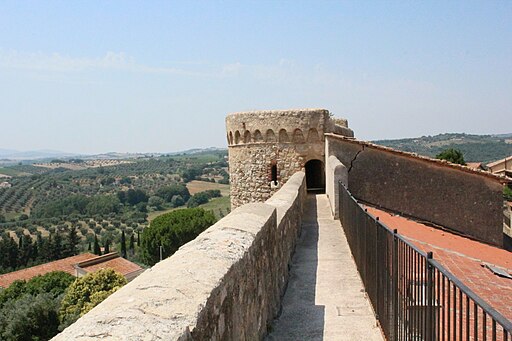 |
||
Particolare del giro delle mura
|
Mura di Magliano in Toscana
|
Mura di Magliano in Toscana | ||
| Monastero di San Bruzio |
||||
| Just a few miles off the village of Magliano, in an area rich of Etruscan tombs, wonderful olive tree groves and fields that in spring are filled with wild orchids, you can find the ruins of the romanesque church of Saint Tiburzio, best known with the gross name of Saint Bruzio. Already cited in the XIII century, it hosted the secular clergymen of the diocese, that here lived together in a community that was similar to a monastery. From Magliano, take the road back to the intersection for Marsiliana and head left (the only way). Not far from the intersection, on your left you'll see the remains of the church. Annunziata church, containing Sienese frescoes. About 2km southeast, on the Marsiliana road, are the ruins of the 12th-century abbey of San Bruzio.
|
||||
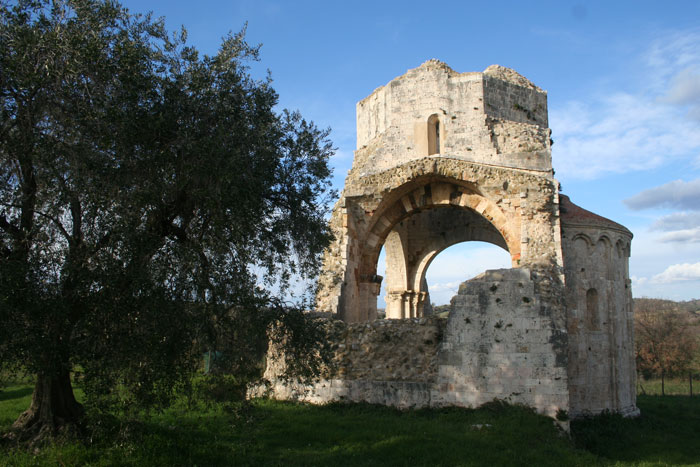 |
Monastero di San Bruzio, Magliano in Toscana |
| Montiano is a typical borgo of the hilly Tuscany with remarkable findings of the past such as the church of San Giovanni and the Torre dell'Orologio (The Watch Tower). Besides its art and history, Montiaino is famous for being an authentic terrace at Maremma, with extraordinary windows towards the sea and the surrounding countryside. Once very nice and undulated, other times so wild and intricate, however always beautiful. During the light days, it would be worth paying for a ticket for the view that opens up in front of you. Situated in a strategic position, Montiano became an Etruscan agglomeration, a domain of Aldobrandeschi and later on, a castle of Siena. There are rare but significant traces such as ancient palaces and ruins of the town walls that prove the existence of different historical events. In 1554, the village suffered a devastating raid lead by barbarous pirates. |
|||
| Pereta is a mediaeval village in southern Tuscany, dating back as far as the 9th century, especially interesting for its small houses, tightly set against each other. Its characteristic arched entrance to the old village and the tall watch tower perched at the top of attractive cobbled alleyways are proud features in this small and friendly village. Pereta, is dominated by a big Tower, the Torre dell'Orologio, which was part of the old fortress. There is the church Pieve di S. Maria of the 15th century, whose facade is decorated with a valuable rosette and a bell tower. The oldest building in the village is the little church S. Giovanni Battista of the 13th century, which has baroque and neoclassic decorations inside. Pereta is found along the SS323 about halfway between Magliano in Toscana and Scansano, in the heart of the production zone of the same famous wine Morellino di Scansano D.O.C.. Thanks to its strategic position on a highland at the center of an area always contested between the local lords – the Aldobrandeschi most importantantly and Siena, Pereta was already an important military center in the 10th and 11th centuries. The village is made up of two distinct nuclei. The older one, from the 13th century, is surrounded by an elliptically shaped wall that is still recognizable even if partially incorporated in the houses that make up a part of the walls. The buildings go up the slope to the top of the hill and finish with a very fine tower of which the actual form is from the 15th century. It is 29 meters high and today is named the “Clock Tower”. The tower is square-shaped and built with sandstone. The numerous external slots make it almost certain of the previous existence of some jutting wooden structures. One of the ancient entrances is still visible within the urban area in front of the Pieve of Santa Maria. The ancient nucleus is surrounded by a second circle of walls, in which are visibile two towers, one square and one round, and a gate with a ogee arch, the base of which is greatly tilted because of the large amounts of changes made in the 19th century. |
|
||
Cycling in Tuscany | 13. Profumo di Morellino | The scent of morellino wine - 39 km
|
|||
Enlarge map |
|||
| The village of Pereta is 6 kilometers far from Magliano in Toscana to whom it belongs.
To the municipality of Magliano in Toscana also belong the localities of Alberese Scalo (18,23 km), Cupi (15,76 km), Montiano (9,35 km), Podere Corso (8,36 km), Poderone (3,71 km), Sant`Andrea (6,95 km), Stazione di Alberese (18,09 km). |
|||
Restaurants in Scansano, Pereta and Magliano in Toscana Scansano La Cantina Di Simone, Vittorio Emanuele N. 14, 58054 Scansano | www.simoneilsalumiere.it Enoteca dei Mille, Piazza Garibaldi 2, 58054 Scansano | www.enotecadeimille.it/ Pane E Tulipani | Morelliana Food & Wine, Via IV Novembre, 19/21, 58054 Scansano La Cantina, Via della Botte, 1, 50854 Scansano | www.provveditore.it Il Grottone, Vicolo degli Addobbi, 2, 58054 Scansano
Pereta
|
|||
|
|||
 |
|||
| Podere Santa Pia, situated in a particularly scenic valley, overlooking the hills around Cinigiano, up to Montecristo and Corsica
|
|||
[1] Parco Eolico Poggio Alti | In 2007 Endesa Italia has inaugurated a 20 MW wind farm in Poggi Alti, in the municipal territory of Scansano. The park has ten turbines 67 meters high built by Gamesa, with 2 MW capacity each. This is an insult to the beautiful area of Southern Maremma. |
|||

